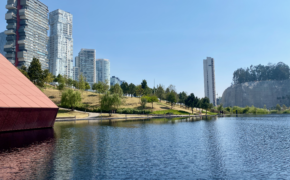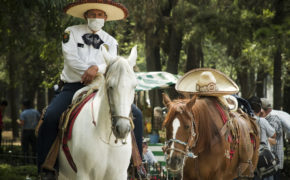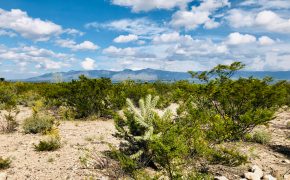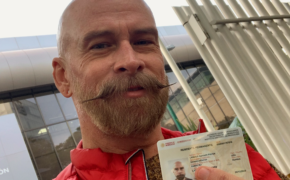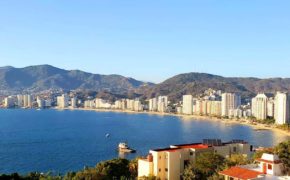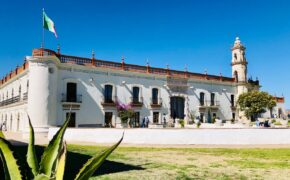Religious Architecture in Spanish America
When the Spanish first arrived in America, they did not expect to find advanced civilizations and cultures. It must have been a great surprise, then, when they first visited Tenochtitlan, capital of the Aztec empire, a great city in the middle of a lake laid out in a grid pattern, organized around a central ceremonial district where the awesome, fear provoking, Templo Mayor was housed. Equally impressive was Cuzco, the sacred city of the Incas, from which all points of the Inca Empire could be reached in a way familiar to the Spanish in the Old World adage “All roads lead to Rome.” At its heart lay the Temple of the Sun, the Coricancha, built of imperial monumental stone covered in glistening gold which was stripped away to provide ransom for the Sapa Inca who, despite his loyal subjects’ best efforts, was assassinated by Pizarro whose greed for gold in Peru was as insatiable as that of Cortez in Mexico. In contrast with the cultures of Mexico and Peru, the American Southwest largely met the Spaniards’ expectations of a desolate, barren land sparsely populated by inferior races.
Much of the information used in this report on Spanish religious architecture in the American Southwest comes from Roger G. Kennedy’s book, Mission: The History and Architecture of the Missions of North America and Stanley Young’s book, The Missions of California. This paper also makes use of the work of Samuel Edgerton’s book, Theaters of Conversion: Religious Architecture and Indian Artisans in Colonial Mexico, to establish the evangelical purpose of Spanish colonial religious architecture in the American Southwest and in Mesoamerica. Additional sources of information about Spanish colonial religious architecture in Mesoamerica are James Early’s book, The Colonial Architecture of Mexico and Joseph Baird’s The Churches of Mexico, 1530-1810. Information about architecture in Mexico and Peru comes primarily from the Isabella Stewart Gardner Museum’s book The Word Made Image: Religion, Art and Architecture in Spain and Spanish America, 1500-1600. Rounding out the story of religious architecture in Peru are Valerie Fraser’s book, The Architecture of Conquest: Building in the Viceroyalty of Peru, 1535-1635, as well as Damian Bayón and Murillo Marx’s book, History of South American Colonial Art and Architecture: Spanish South America and Brazil.
In an attempt to appease European critics concerned by reports of brutal Spanish colonialism in Mexico and Peru, the Spanish offered graphic images and descriptions of the religious practices of the indigenous peoples which included such horrifying practices as human (adult and child) sacrifice, cannibalism and the worship of demon idols. Intended as anti-Spanish propaganda to enforce the idea of the “Black Legend” of Spanish Colonization, the works of Theodore DeBry, a Flemish printer who fled to Germany during the Flemish revolt against Spanish rule, were published in Great Voyages, his account of his travels to America. Produced en masse to educate the inquisitive Europeans about the peoples of the Americas and the atrocities committed against them by the Spanish, DeBry’s shocking images were misappropriated in order to legitimize the Spanish presence in the Americas as necessary to provide for the opportunity of Christian evangelization and redemption of the apparently savage pagans. Under these deceptive premises, the Catholic Church provided moral cover for the consequential subjugation of the Native American peoples and the plundering of their wealth by the Imperial Spanish.
In the course of a century, an astonishingly rapid timeframe, mendicant friars from Spain came to Mexico and established elaborate structures dedicated to the worship of Christ. Having taken vows of poverty, the mendicant friars had no outward interest in the wealth that would be plundered by the Spanish in America. They simply came along to evangelize the peoples living in these vast new lands deliberately following the example of Saint Paul, formerly Saul of Tarsus, who in one of his trips to Athens stood in the Areopagus and proclaimed:
Men of Athens, I note that in every respect you are scrupulously religious. As I walked around looking at your shrines, I even discovered an altar inscribed, ‘To a God Unknown.’ Now what you are thus worshiping in ignorance I intend to make known to you. For the God who made the world and all that is in it, the Lord of heaven and earth, does not dwell in sanctuaries made by human hands; nor does he receive man’s service as if he were in need of it. Rather it is he who gives to all life and breath and everything else” Acts of the Apostles 17:22-25 (New American Bible, 1308).
Paul’s replacement of pagan gods and rituals with new Christian images and sacred rituals established the original, remarkably successful, model of Christian evangelization throughout the Roman Empire in the early days of the Church, based not on supplantation, but rather, syncretism, which the American Heritage Dictionary defines as the “reconciliation or fusion of differing systems of belief, as in philosophy or religion, especially when success is partial or the result is heterogeneous” (np, emphasis added).
In keeping with this Biblical model of evangelization, twelve Franciscan missionaries came to Mexico to establish a home where “a purer, more fundamentalist Christianity would be preached as in the ‘primitive church’ of the original New Testament twelve” (Edgerton, 19). Continuing in the example of Saint Paul in Athens, the friars in Tenochtitlan had observed the Aztec Feast of Panquetzaliztli, which involved a procession around the ceremonial district followed by ingestion of the chief Aztec deity, Huitzilopochtli, in the form of bread (Edgerton, 61). This bore an uncanny resemblance to the Catholic Feast of Corpus Christi which also involved a procession followed by the taking of Holy Communion, which Catholics believe is the ingestion of the Body of Christ after the miracle of Transubstantiation, the literal transformation of bread into the Body of Christ (Edgerton, 63). In an early and deliberate attempt at syncretism, “the friars openly encouraged Indian converts to perform their traditional processions and dances but now Christianized in symbol and content” (Edgerton, 64). Amidst this syncretism, the National Cathedral of Mexico was built.
By the time that the current National Cathedral of Mexico was planned in the late sixteenth century, the mendicant friars had been largely replaced by the secular friars as the Spanish crown reacted to Counter-Reformation pressures by shifting control of converted Indians from the mendicant friars toward the seculars “who were to organize the natives into orderly parishes and dioceses under the inquisitorial eye of the mother church in Spain” (Edgerton, 15). By then, the mendicants had a well-established order for building religious architecture in Mexico, which already bore evidence of syncretism. These included many architectural examples of indigenous origin as well as placement atop indigenous holy sites such as Huejotzingo, among others. However, as the ancient and future capital of Mexico, Tenochtitlan, now Mexico City, required a grand cathedral, and this grand cathedral required a new architectural style, one which would more closely resemble the basilica plan of Spanish cathedrals (Baird, 27).
The Cathedral of La Asunción de María, as it is properly known, was first begun in the 1520s, and completed in the 1530s (Baird, 95). Originally located in the Zócalo, just west of the site of the Templo Mayor, yet still within the Aztec sacred precinct, this first cathedral was replaced by a new, more appropriate cathedral in 1563 along the northern side of the Zócalo (Baird, 95). In a departure from indigenous and Spanish orientations, the cathedral was oriented south to north, the altar at the north “with the Puerto del Perdon toward the Plaza Mayor” (Early, 53). In time, the cathedral was built up to a double-clerestoried basilica according to architectural plans drawn up by Francisco Becerra, later extensively revised by Claudio de Arciniega (Early, 53-4). The principal architectural features of the interior include “three well-lighted barrel-vaulted naves, . . . saucer-domed aisles and tall piers decorated by fluted Doric half-columns which continue up across the barrel vault as transverse arches” resulting in “the tall, airy lightness characteristic of a Gothic cathedral” (Early, 55). The Neo-Classical façade was finished around the turn of the nineteenth century (Baird, 95). The cathedral measures 180 feet wide by 375 long, with twin towers soaring just above 200 feet (Baird, 95). Inside is the renowned Retablo de los Reyes, designed by Gerónimo Balbás (Baird, 96), arching deep into the polygonal apse at the rear wall of the sanctuary (Early, 57). The towers remained unfinished until 1791, when they were finished in Neo-Classical style by José Damián de Castro (Early, 60). The final construction on the exterior was finished in 1813 (Early, 60).
In The Colonial Architecture of Mexico, James Early observes, “New Spain endured for nearly three hundred years. Its principal cathedral was under construction for two hundred and fifty of those years” (60). All of these features point back toward the evangelical mission of the original twelve Franciscan missionaries to establish a home in Mexico where “a purer, more fundamentalist Christianity would be preached as in the ‘primitive church’ of the original New Testament twelve” (Edgerton, 19). Having accomplished the task of conversion, more or less, the Aztec ceremonial district was built over with a cathedral largely devoid of indigenous features. One cannot help but recall the pre-Conquest annals depicting the defeat of towns by the Aztecs with a glyph showing the temple of the old god ablaze. It seems a bit ironic. Despite its magnificence, the Cathedral of Mexico remains to this day a reminder of the Conquest of Mexico, and the role the Church played in that Conquest, at the expense of the native cultures of Mexico.
The Christian evangelization of the people of Peru was less idealized than it was in Mexico, more forceful and violent. Nevertheless, in Peru, the missionaries remembered the advice given by Pope Gregory in 601 to the missionary Mellitus in England, which expanded upon Saint Paul’s evangelical concept:
The temples of the idols ought not to be destroyed, the idols that are housed in them should be. Let holy water be prepared and sprinkled in these temples, let altars be erected and relics placed in them. For, if these temples are well built, they ought to be converted from the cult of devils to the service of the true God. In this way, the people, seeing that their temples have not been destroyed, will remove error from their hearts; they will recognize and worship the true God and will the more willingly gather in the places that are familiar to them. . . . For it is impossible to remove error from their obdurate minds all at once, just as a person who strives to ascend to the most exalted place proceeds by degrees and steps, and not by leaps (MacCormack, 103).
As had been done in Athens and England in the early days of the Church, and more recently in Mexico, the missionaries in Peru built their churches atop indigenous sacred spots, called huacas. In Peru, no huaca was more sacred than the Coricancha, Temple of the Sun, in Cuzco. It is here that the Dominicans built their Convento of Santo Domingo atop the remains of the Coricancha, which had been stripped of its gold to pay ransom for Sapa Inca. The Dominicans recognized that the solid construction of the Coricancha would provide an excellent base for their monastery. The church is laid out as a basilica with side aisles, a flat end wall and an apse with a vestry and choir stalls at the base, in the Spanish custom (Bayon, 49). At the rear are three arches that open out onto the bare old wall of the Coricancha which was either used as an open chapel or as a gallery for exhibiting sacred ornaments (Bayon, 49).
Having transformed the literal heart of the empire into a house dedicated to the worship of Jesus Christ, the Dominicans continued in the traditional evangelical model instructing the natives in the concept of Christianity by drawing parallels to the native religion. This turned out to be so simple and successful that Guaman Poma even suggested that the Incas had, in fact, been worshipping the true God all along (MacCormack, 117). Don Joan de Santacruz Pachacuti Yamqui agreed, drawing parallels between his reproduction of a depiction of Incan cosmology that had adorned the main wall of the Coricancha, and Christian cosmology. This included a gold disk representing the Creator, which the fourth Inca, Mayta Capac, had installed in the Coricancha telling his people “to know God with only the intellect as the powerful Lord and Ruler and Maker, setting aside all other things, the elements and the highest creatures” (MacCormack 117-8). This pre-existing understanding of the Cosmos proved useful to the missionaries in the evangelization of Peru, even more so than had been the case in Mexico with the Feast of Corpus Christi and the Aztec Feast of Panquetzaliztli.
Indeed, to Pachacuti Yamqui, the Spanish occupation of Cuzco seemed a religious event (MacCormack, 118). The memory of the violent Spanish invasion of Cuzco became replaced, at least in his mind, with an image of the Spanish entry into Cuzco resembling one of the many solemn Christian processions with which he had become familiar. About this idea, he wrote:
The Marquess (Francisco Pizarro) entered into the city with (Manco) Inca, in company of the holy gospel of Jesus Christ our Lord with great royal splendor and pomp of great majesty. The Marquess with his white hair and long beard represented the person of the emperor Charles V, and the father friar Vincent with his mitre and cope represented the person of Saint Peter the Roman pontiff . . . and there was the Inca in his litter adorned with featherwork in his most splendid garments, and the suntar paucar (scepter) in his hand, as a king. . . . In the end, Friar Vincent went straight to Coricancha, the house built by the ancient Incas for the Creator. In this way, the law of God and his holy gospel, so much yearned for, entered to take possession of the new vineyard (MacCormack, 119).
The Monastery of Santo Domingo stands to this day, an inferior structure to the Coricancha it replaced, at the heart of the Inca Empire, as an enduring reminder of the Conquest of Peru. The Spanish missionaries managed, once again, to employ syncretism to convert the indigenous people to Christianity. Even more significant and important to the Conquering Spanish, they altered the lingering memory of the violent overthrow of the Inca and his empire.
In contrast with the examples in Mexico and Peru, the California missions were not built upon existing indigenous religious sites, as advanced civilizations had not yet developed along the coast of California. In response to the establishment of Russian settlements along the northern coast of California, this chain of missions was established along the coast from San Diego to north of the Bay Area, specifically to cement Spain’s claim of the territory (Levick, 5). Again, the Spanish enlisted the moral authority of the Church to provide legitimacy for their imperialistic plans, though Levick notes, “the historical irony is that the missionaries came with the purest of hearts and motives” (7). If this was true, then the California native peoples’ road to hell was paved with good intentions.
The Mission of San Diego de Alcalá was founded in 1769 at a site known today as Presidio Hill (Levick 11-12). Franciscan Padre Junipero Serra raised a cross, said mass and then summoned the local people by ringing a large bell that had been hung from a tree (Levick, 12). The mission was moved in 1774 to the site where it remains today in order to be closer to the indigenous people and a fresh water supply, the San Diego River (Levick, 12). The mission was constructed in the simple manner that had been used so successfully throughout Mexico, though the lack of building materials and skilled workers required adobe (mud brick) construction (Levick, 7).
At this site, the first of what would become a chain of 21 missions and six asistencias stretching north along the California coast from San Diego to north of San Francisco Bay, all was not well and good. The mission encountered resistance from the native people who were unimpressed by the Spanish toehold on their territory. Violence flared up in 1775 resulting in the death of Padre Luis Jayme, the first Christian martyr in California, whose remains are buried beneath the sanctuary of Mission San Diego (Levick, 12). The native population of California, numbering perhaps as many as 100,000 at the time of the Spanish arrival (Levick, 6), was reduced by as much as 80% as a result of exposure to diseases borne by the Spanish for which they had no natural immunity (Kennedy, 171). Following conversion to Christianity, the native people were more or less owned by the mission, subject to forcible retrieval and punishment if they fled (Levick, 6). When they were set free following Mexican independence, they suffered further as their cultures and tribes had been completely eliminated during the century of Spanish colonization in California (Levick, 7 and Kennedy, 171). Insult was added to injury as Mexican settlers arrived and deceptively took control of lands intended to belong again to the native peoples (Levick, 7).
Today the missions of California stand, somewhat restored and glorified, as a romantic link to the past for many Californians. To the descendents of the native people of California, however, they are a reminder of a dark time of suffering and servitude at the hands of the Spanish and, in particular, at the hands of the Catholic Church. Ironically, despite this history, several of the missions continue to serve native populations, notably Mission Santa Barbara and Mission San Antonio de Pala, an asistencia which was originally established by Mission San Luis Rey in Oceanside in order to serve the nearby inland native population which remains today on a reservation in the community of Pala, twenty miles inland.
Despite the lofty moral premises that justified the founding of all of these sites throughout Mexico, Peru and California, they nevertheless contributed to the decimation and subjugation of indigenous peoples and the plundering of their wealth and their lands at the hands of the Imperial Spanish. In her book, The Architecture of Conquest, Valerie Fraser notes, “These churches are the product of the indigenous people’s first experience of working for the new power. Their construction serves as an introduction to a new culture, to a new style of architecture, and to a new set of materials and techniques, as well as to a new form of economy” (167).
Where they survived colonization, the indigenous people of the Americas for the most part did embrace Christianity. However, they did so on their own terms preserving the ideas and sacred sites of their indigenous religion and cosmology. In so doing, they preserved aspects of their religions and cultures for future generations. Emerging from this syncretism of cultures came the unique mestizo (mixed) cultures now found throughout the Americas. Neither completely Spanish nor completely indigenous, these cultures by their very existence question the notion of Spanish “conquest” of the Americas, pointing rather to a mutual syncretism, with success being partial and the result obviously heterogeneous. However, the plundering of wealth and the decimation and subjugation of the indigenous people that occurred under the false premise of Christian evangelization and redemption can never be denied.
Bibliography
The American Heritage Dictionary of the English Language, 4th ed. Boston: Houghton Mifflin Company, 2000. http://dictionary.reference.com/search?q=syncretism
Baird, Joseph Armstrong. The Churches of Mexico, 1530-1810.
Berkeley: University of California Press, 1962.
Bayon, Damian and Murillo Marx. History of South American Colonial Art and Architecture: Spanish South America and Brazil. New York: Rizzoli, 1992.
Early, James. The Colonial Architecture of Mexico. Albuquerque: University of New Mexico Press, 1994.
Edgerton, Samuel Y. Theaters of Conversion: Religious Architecture and Indian Artisans in Colonial Mexico. Albuquerque: University of New Mexico Press, 2001.
Fraser, Valerie. The Architecture of Conquest: Building in the Viceroyalty of Peru, 1535-1635. Cambridge: Cambridge University Press, 1990.
Isabella Stewart Gardner Museum. The Word Made Image: Religion, Art and Architecture in Spain and Spanish America, 1500-1600. Boston: Trustees of the Isabella Stewart Gardner Museum, 1998.
Kennedy, Roger G. Mission: The History and Architecture of the Missions of North America. Boston, New York: Houghton Mifflin Company, 1993.
MacCormack, Sabine. “Art in A Missionary Context: Images from Europe and the Andes in the Church of Andahuaylillas near Cuzco”. University of Michigan: Isabella Stewart Gardner Museum, ed. The Word Made Image: Religion, Art and Architecture in Spain and Spanish America, 1500-1600. Boston: Trustees of the Isabella Stewart Gardner Museum, 1998.
The New American Bible. Catholic Biblical Association of America, gen. eds. New York and Cleveland: Collins Publishers, 1976.
Young, Stanley. The Missions of California. San Francisco: Chronicle Books, 1988.

